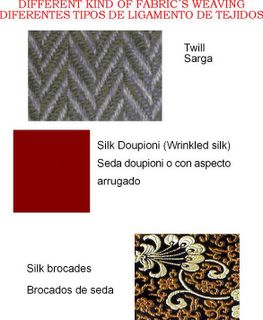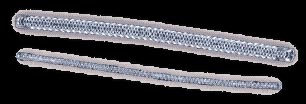Fabrics II

Different kind of fabrics

For outer fabrics, in last post I will commented that we can use some kind of fabrics. In the picture above, we can see these fabrics.
Twill: a fabric so woven as to have a surface of diagonal parallel ridges.
Doupini: Silk yarns made from the cocoon of two silk worms that have nested together. In spinning, the double strand is not separated so the yarn is uneven and irregular with a large diameter in places. Fabric is of silk made in a plain weave. The fabric is very irregular and shows many slubs- seems to be made in a hit and miss manner. It is imitated inrayon and some synthetics, and one such fabric is called "Cupioni".
Brocades: Rich, heavy, elaborate design effect. Sometimes with coloured or metallic threads making the design usually against a satin weave background. This makes the figures stand out. the figures in brocade are rather loose, while in damask the figure threads are actually bound into the material. The pattern may be satin on a twill ground or twill on a satin ground. Often reversible. The motifs may be of flowers, foliage, scrollwork, pastoral scenes, or other designs. The price range is wide. Generally reputed to have been developed from the Latin name "brocade" which means to figure.
Tipos diferentes de tejidos
Para el tejido exterior, en el post anterior comenté que podemos utilizar varios tipos de tejidos. En el dibujo podemos verlos.
Sarga: Sarga es la forma en la que están los hilos dispuestos en la tejeduría, es decir, dispuestos en diagonal.
Doupini: Los hilos de la seda proceden del capullo de dos gusanos de seda que se han hilado juntos. En la hilatura, el filamento doble no está separado, por lo que el hilo es irregular con diferentes diámetros en algunas zonas. El tejido de seda se hace en un ligamento 1,1 (plana como el tafetán). El tejido resultante es muy irregular presentando numerosas arrugas, hilos muertos y falta de hilo. Es muy imitado en rayón y en otras fibras sintéticas, el tejido resultante se denomina "Cupioni".
Brocades: Rico, pesado y elaborado a la espera de un resultado llamativo. ALgunas veces se utiliza un hilo metálico o coloreado para que resalte en el fondo de ligamento satén. Normalmente el hilo coloreado o metálico dibuja siluetas, las cuales está ligeramente desligadas del fondo mientras que los hilos en un damasco, al igual que el jaquard, forman el dibujo mientras se teje el tejido. El patrón que sigue suelen ser satén, sarga, sargas o satenes ground. Normlamente suelen ser tejidos reversibles (es decir, con el mismo dibujo en ambos lados). Los motivos de los dibujos suelen ser florales, hojas, escenas pastorales, The motifs may be of flowers, foliage, scrollwork, así como otros diseños. Suelen ser tejidos o muy baratos o muy caros, su intervalo de precios es muy amplio. Se llaman brocados de latín brocade que significa figura.


















